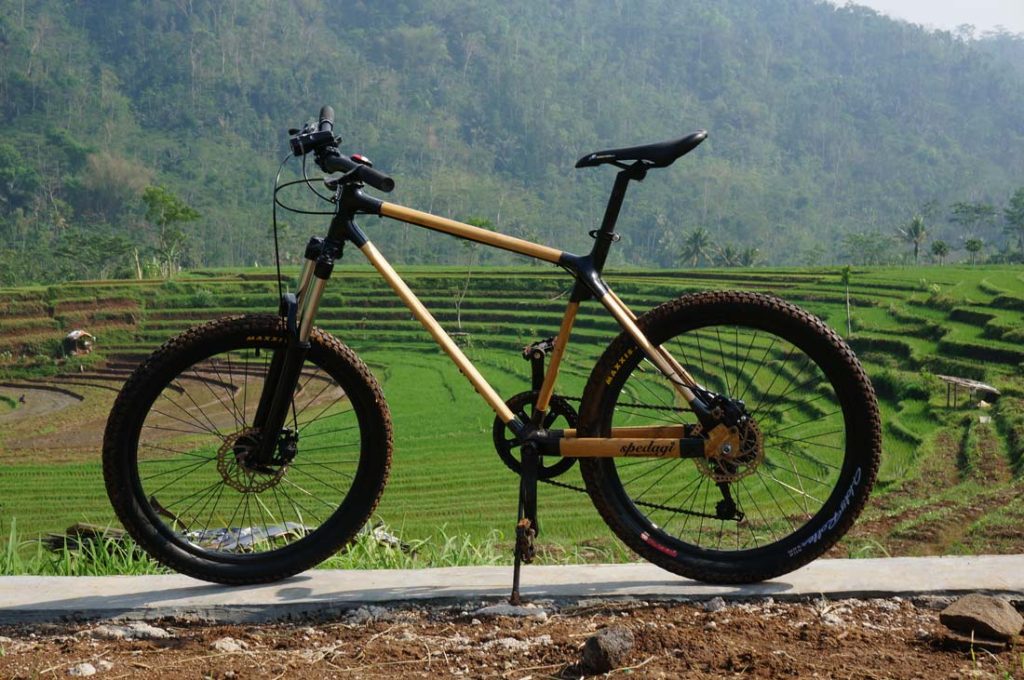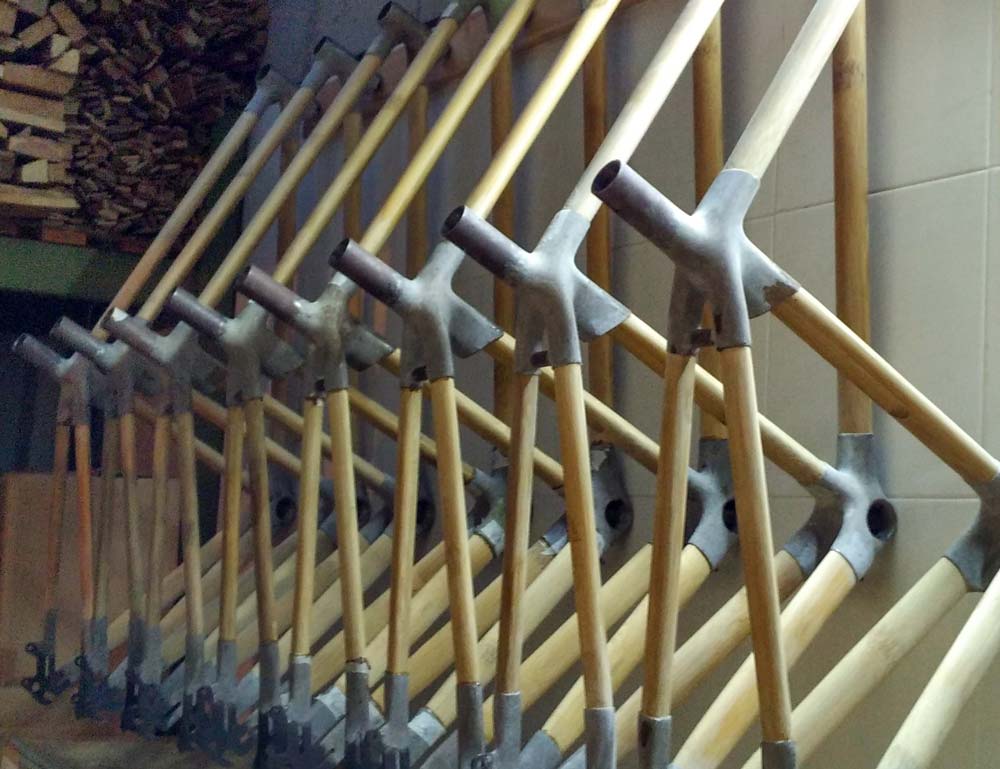
Melding technology and nature in a sustainable and aesthetic way, artist and designer Singgih Susilo Kartono has created Spedagi, bamboo bikes that rekindle the human-nature relationship. In turn, this unique product has also triggered the revitalisation of his home village in Central Java. Photos by Spedagi.
Humans have utilised bamboo for over 5,000 years. It’s the fasting growing and most regenerative plant on earth, and is widely available. It has a relatively short cutting age, between 3-5 years, and doesn’t require replanting. It’s a fertiliser, storage of water, protects from soil erosion and has a high output of oxygen. On the material side, it is local, renewable, malleable and flexible. It used in textiles, flooring, furniture and now… even bicycles.
Singgih Susilo Kartono was first recognised by his award-winning ‘Magno’ radio in 2004; a retro-styled wooden radio made by hand by craftsmen in his Temanggung, Central Java, each radio a single piece. Spedagi, a bicycle made out of bamboo, is also a product born of handicraft. Taking its name from ‘sepeda pagi’, i.e. the morning cycle, it was inspired by Singgih’s own morning cycles to lower his cholesterol which in turn started an interest in bicycle design.

“I was fascinated by the beauty of the bamboo bicycle by Craig Calfee, a professional bicycle designer in the USA where the bicycle was used by Greg Lemond, a three-time Tour de France winner. The bamboo materials and handcrafting process can produce works where function and beauty are balanced,” shares the inspired designer. Upon reading more, he discovered new feats of the poaceae plant: “Bamboo is the best vibration absorbing material compared to all other materials used to make bicycles so far. I realised, it’s certainly not easy to get bamboo in America. Due to its rarity Craig was able to see the special attributes of this natural material. This hit me hard, because bamboo is so abundant in the area where I live. Close proximity and abundance can actually create ‘farsightedness’, making us not recognise the special things around us. So, I decided to start designing and building bamboo bikes.”
Thus, the Spedagi design phase started in early 2013, and production began at the end of 2014, with continuous improvements on technical design along the way.
Singgih never designed a product starting with market demand, but rather from the belief that a product needed to be made. He’s also accustomed to carrying out his research and development through “coro ndeso”, Javanese for ‘the village way’. This involves gaining information about bicycles and bamboo, and then just experimenting directly.



“For bicycles and manufacturing techniques, I learned completely from the internet, also from a friend who taught me about bicycle frame geometry. I studied bicycle parts and how to ride a bicycle properly. I also had to prove to myself that bamboo was indeed a worthy material for bicycles frames. So, I made myself bamboo bicycle based on something off the internet and rode it around — it really is strong!” remembers Singgih.
After a lot of testing, Singgih chose to use petung or giant bamboo (Dendrocalamus asper), the strongest types of bamboo with a large diameter and thick wall which makes it possible to create frame tubes with a uniform size. Singgih also combined it with metal joints to provide good stability and strength., but decided against integrating carbon fibre as to minimise imported materials. Singgih admitted that making metal joints is also not easy because there is no metal industry around him. In the end, he adopted metal skills and finished it in a welding workshop and a car body repair shop. Though the technology is rudimentary, the assured for high quality standards — limitation and locality, was what gave birth to originality.
“Bicycle products are supposed to go through laboratory testing to measure their strength, but my village is far from any such facility. So, I had to conduct my own tests. The frame broke and cracked a few times, prompting me to switch from fibre-resin to metal joints. The Spedagi frame was finally tested in a lab for the first time in 2017 in Japan, passing the test. In the same year, several cyclist acquaintances began to carry out long-distance driving tests: Spedagi was used for a cycling journey from Jakarta to Temanggung, covering a distance of 450 km.” Singgih said. Since then, the plant-produced push-bike has achieved other long-distance milestones: Paris-Brest-Paris in 2019 (1200km), Banda Aceh-Bali in 2022 (3700km), and Jakarta – East Nusa Tenggara (2000 km) in January 2023.
Bamboo’s flexibility, if constructed into the frame well, provides for ultimate cycling comfort. Testimonials from active cyclists, used to their top-of-the-line carbon fibre, state that bamboo bicycle frames are much more comfortable when riding on rough or uneven texture roads.

On top of all that, the bamboo bicycles present a sleek and unique aesthetic, earning Spedagi a prestigious Gold Award in Good Design Japan 2018, gaining fame across the world from USA to Europe. President Joko Widodo even took the Spedagi out for a spin, together with the Australian Prime Minister, Anthony Albanese, in the Bogor Botanical Gardens area.
There are four types of bamboo bicycles that are regularly produced, namely Dalanrata (road bike), Dwiguna (hybrid bike), Rodacilik (minivelo), and Gowesmulyo (joy bike/city bike). Currently, Singgih is in the process of designing a more affordable model of Spedagi called GORo (Gotong Royong), a prototype of which was launched at the G20 Summit event in Bali. Singgih wants bamboo bicycles to become the people’s bike, and a vehicle to grow social movement that contribute to improving lives.
The development of Spedagi became more than just the creation of a bicycle — it created a sustainable resource-based industry in Singgih’s village, it helped to counter one of the biggest problems the village was facing: ‘brain drain’. He explains, “Villages do not progress and develop partly because of the loss of an educated and skilled generation who choose to live and work in cities. I then realised that these bamboo bicycles can actually be a “magnet”, that they had the potential as a social transformation tool. This situation later gave birth to the Spedagi Movement, a social movement that focuses on the issue of Village Revitalisation.

The Spedagi bamboo bicycle is an excellent metaphor and symbol for this movement: It’s not that the material is bad, but our perspective on the material (bamboo) is wrong; this is the same as our perspective on the village. The real village is a community with an advanced design, but our perspective of the village has left it neglected. That’s why village revitalisation is needed,” says Singgih, who since 1995 has been working in the village where he was born in Kandangan, Temanggung, Central Java. He passionately believes that our future lies in these villages.
Those of you who are interested in riding one of these bamboo bikes can join in a Spedagi Bike Tour. Apart from riding on bamboo bicycles, this tour invites participants to be able to see the village from two sides. Participants are not only invited to enjoy the beauty of the village but to see firsthand the potential and problems faced by village communities.
For more information about visit their website or follow them on Instagram:
@spedagibamboobike | spedagi.com







